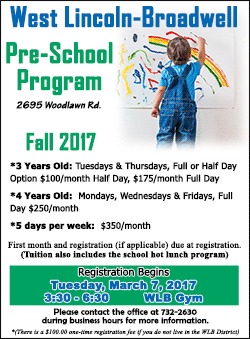|
 The past couple of years has seen many new advances and
initiatives in the education field, including new technologies,
assessments and pedagogies. Many of these are making their way into
classrooms across the country, but on a local level, you would be
hard pressed to find a school as immersed in the new “maker
movement” than western Logan County school district New
Holland-Middletown #88. The past couple of years has seen many new advances and
initiatives in the education field, including new technologies,
assessments and pedagogies. Many of these are making their way into
classrooms across the country, but on a local level, you would be
hard pressed to find a school as immersed in the new “maker
movement” than western Logan County school district New
Holland-Middletown #88.
A paradigm in education, known as “design thinking,” is a method of
instruction that discourages the production of a single answer, but
multiple solutions to problems. NH-M has been actively implementing
such approaches in their district initiatives for a number of years,
but has most recently seen success. The culminating achievement for
the district arrived with the receipt of a large monetary grant to
transform an unused classroom into a 21st century “maker space.”


The so-called “maker movement” involves schools providing students
with tools and problems that they must solve, or “make,” on their
own. NH-M has had the tools in place for nearly four years with its
early adoption of providing ubiquitous Internet access and a device
to every student in its district.
Currently, the district issues iPads to students in grades K-second,
Google Chromebooks in third through eighth grades, and is currently
piloting several Microsoft Surface devices.
While the students now have complete access to the world at their
fingertips, they have been among the first in central Illinois to
experience “design thinking.”

NH-M has created the only dedicated central “maker space” to its
students in Logan County. The old unused classroom has now been
transformed into a “dream lab” where students can bring their ideas
to life. For use by all students in grades K-eighth grade, the maker
space is a collection of tools where students can design, create,
and tinker their ideas.
In one corner is a 3-dimensional ink pen, where students integrate
their artistic abilities. The opposite corner houses a large
1000-piece puzzle.


Along the adjacent wall is a large bookcase filled with tools and
everyday items, some of them cast-offs from home, which are used by
students to “make” things to solve a problem (this collection
includes Legos, play-doh, cupcake wrappers, pom pon balls, school
glue, toilet paper rolls, paper cups, pipe cleaners, etc.)

Moving to the next wall is a large, 75” interactive display that
closely resembles a flat screen television but is in reality hooked
up to a PC that has CAD software (used often by architects and
engineers) pre-loaded.

[to top of second column] |
 As students create their own designs, they are able to manipulate
the objects by mathematical distances and by geometric relationships
before sending the object to a 3-D printer next to it.

Finally, a table of obsolete desktop computers and laptops with
Windows XP (or older systems) mark the “tinkering station,” where
students are encouraged to tinker by taking apart and putting back
together. This version of reverse engineering is highly engaging for
students not typically motivated by traditional seat work.

A large selection of screwdrivers and old computers provide hours of
engaged tinkering for several students at the junior high level.
While this new approach to learning can easily be integrated into
every subject, none lends itself more easily than Math or Science.
In fact, due to the forecast shortage of jobs in the STEM (Science
Technology Engineering Math) fields, NH-M has created an exploratory
course called STEAM (the A stands for Art) that utilizes the maker
space frequently.
 Most notably, the students were assigned a project to design a
classroom by using the Floorplanner application on their Chromebooks.
The District’s architect, Ms. Shanna Fish from Shive-Hattery,
provided the students with guidance as they began, and informed them
she would return to help grade the final projects.
Other subjects have successfully incorporated “design thinking” into
the curriculum, such as music class. In their enrichment class,
Music Appreciation, students were assigned to “make” a working
instrument. One student fashioned a clarinet mouthpiece on Tinkercad,
and 3-D printed a working mouthpiece!
With a new emphasis on deeper understanding of skills as called for
in the New Illinois Learning Standards (previously Common Core),
this new method of instruction is one that NH-M’s Superintendent,
Todd Dugan, sees as “vitally important if we are to prepare students
for careers of the 21st Century. Too often, we ‘prepare’ students
for a future that closely resembles our own past instead of a future
that does not exist yet.
Design thinking and the maker movement are definitely steps in the
right direction as educators seek to prepare all students for
careers and college.”
|